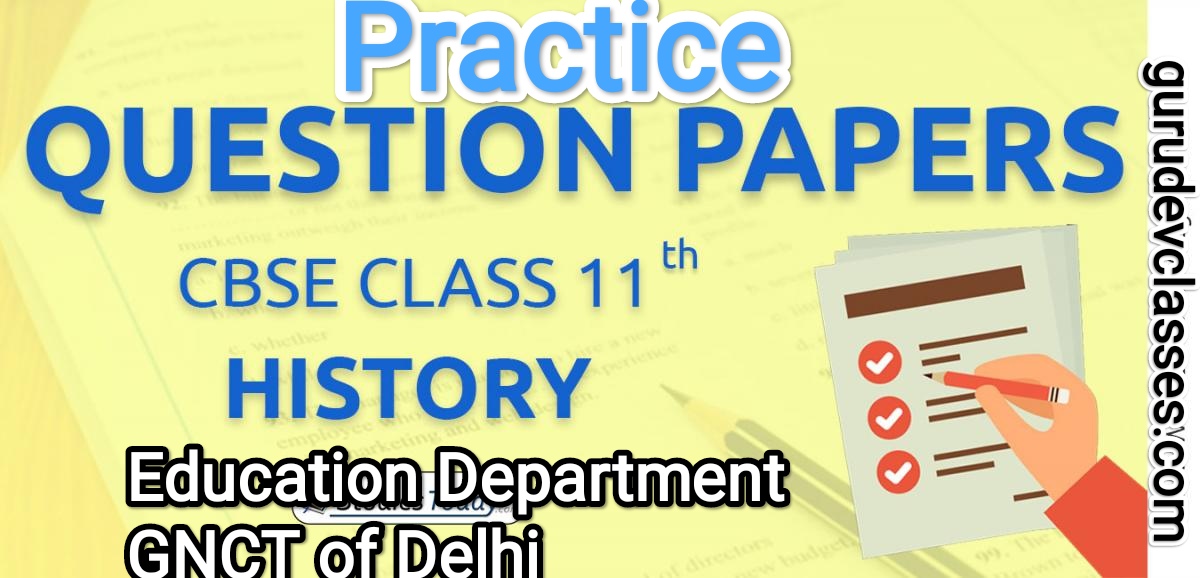Solved Paper – History (Class XI, Code 027)
Time allowed: 3 Hours | Maximum Marks: 80
SECTION A (MCQs) (1×21=21)
Q1. The first written documents of Mesopotamia were primarily used for:
a) Recording royal achievements
b) Keeping trade accounts
c) Writing religious hymns
d) Narrating myths
Ans. (b) Keeping trade accounts
Q2. The earliest Mesopotamian tablets were written in _______ script.
a) Hieroglyphic b) Cuneiform
c) Brahmi d) Phoenician
Ans. (b) Cuneiform
Q3. Which one of the following statements is incorrect?
a) Mesopotamian temples were known as Ziggurats
b) Ur and Uruk were prominent Mesopotamian cities.
c) Gilgamesh Epic belongs to Mesopotamia
d) Mesopotamians used papyrus for writing
Ans. (d) Mesopotamians used papyrus for writing
Q4. A student found a clay tablet with wedge-shaped signs about barley rations. This tablet most likely belonged to which category?
a) Literature
b) Economic record
c) Astronomical observation
d) Historical annals
Ans. (b) Economic record
Q5. Match the following:
- Ziggurat → (b) Stepped temple tower
- Uruk → (a) Earliest urban settlement
- Cuneiform → (c) Writing system
- Hammurabi → (d) Law code
Correct Match: 1-b, 2-a, 3-c, 4-d
Q6. The language of administration and higher literature in the Roman Empire was
a) Greek
b) Latin
c) Aramaic
d) Persian
Ans. (b) Latin
Q7. The capital of the Mongol Empire under Genghis Khan was:
a) Samarkand
b) Beijing
c) Karakorum
d) Bukhara
Ans. (c) Karakorum
Q8. What were the large landed estates of medieval Europe called?
a) Manors
b) Fiefs
c) Guilds
d) Townships
Ans. (a) Manors
Q9. Which river divided the Eastern and Western parts of the Roman Empire?
a) Tiber
b) Danube
c) Rhine
d) None of these
Ans. (b) Danube
Q10. The monument shown in the image is:
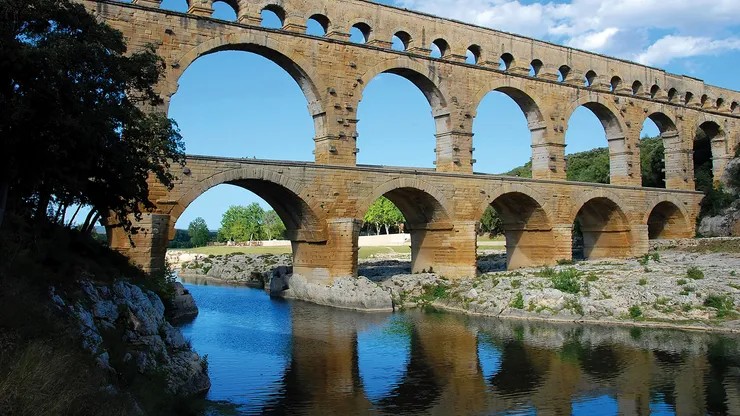
a) Pantheon
b) Colosseum
c) Pont du Gard
d) Aqueduct
Ans. (d) Aqueduct
Q11. Which of the following was NOT a feature of Roman society?
a) Slavery existed
b) Senate was powerful
c) Christianity was dominant from the beginning
d) Expansion through conquest
Ans. (c) Christianity was dominant from the beginning
Q12. A Roman soldier carrying grain from Egypt to Rome reflects which aspect of the empire?
a) Military power
b) Dependence on provinces for food supply
c) Religious rituals
d) Artistic tradition
Ans. (b) Dependence on provinces for food supply
Q13. Which of the following statements is correct?
a) Mongols were originally pastoral nomads
b) Mongols depended only on settled agriculture
c) Genghis Khan was defeated by Chinese rulers
d) Mongols never expanded beyond Mongolia
Ans. (a) Mongols were originally pastoral nomads
Q14. A caravan crossing the Silk Route during Mongol rule faced fewer dangers. This situation reflects:
a) Mongol decline
b) Pax Mongolica
c) Religious tolerance
d) Rise of feudal lords
Ans. (b) Pax Mongolica
Q15. The recruitment of skilled artisans and administrators from conquered areas by the Mongols shows their:
a) Lack of skills
b) Assimilation of diverse cultures
c) Indifference to governance
d) Dependence only on pastoral
Ans. (b) Assimilation of diverse cultures
Q16. The ‘three orders’ in medieval European society were:
a) Nobility, Peasantry, and Clergy
b) Traders, Peasantry, and Soldiers
c) Kings, Lords, and Artisans
d) Knights, Serfs, and Townsmen
Ans. (a) Nobility, Peasantry, and Clergy
Q17. Which statement is incorrect?
a) Serfs were tied to the land
b) Monks lived in monasteries
c) Knights followed a code of chivalry
d) Peasants freely moved from one manor to another
Ans. (d) Peasants freely moved from one manor to another
Q18. If a medieval European peasant had to give one-tenth of his produce to the church, this payment was known as:
a) Rent
b) Tithe
c) Feudal due
d) Tax
Ans. (b) Tithe
Q19. A knight defending his lord’s manor during Viking attacks reflects which feature of feudalism?
a) Manorial dues
b) Vassal-lord relationship
c) Monastic orders
d) Guild system
Ans. (b) Vassal-lord relationship
Q20. Assertion (A): The rise of towns weakened the feudal system in Europe.
Reason (R): Towns encouraged trade, money economy, and independent governance.
a) Both A and R are true, and R is the correct explanation
b) Both A and R are true, but R is not the correct explanation
c) A is true, but R is false
d) A is false, but R is true
Ans. (a) Both A and R are true, and R is the correct explanation
Q21. The Epic of Gilgamesh belonged to which civilisation?
a) Egyptian
b) Mesopotamian
c) Indus Valley
d)Chinese
Ans. (b) Mesopotamian
SECTION B (Short Answer Questions) (3×6=18)
Q22. (a) Evaluate the role of the Roman army in the expansion and consolidation of the Roman Empire.
Ans:
- The Roman army was disciplined, well-trained, and organized into legions.
- Through conquests, Rome extended from Britain to Mesopotamia.
- The army also built roads, forts, and maintained law and order, ensuring consolidation.
(60–80 words)
OR
Q22 (b). Examine the significance of trade and urban centres in the Roman Empire.
Ans:
- Trade connected provinces with Rome, supplying grain, wine, olive oil, and luxury goods.
- Urban centres like Rome, Alexandria, and Antioch became hubs of commerce and culture.
- Trade and cities strengthened economic integration and political stability of the empire.
Q23 (a). Analyse the contributions of Genghis Khan in the making of the Mongol Empire.
Ans:
- United Mongol tribes under his leadership (1206).
- Introduced merit-based promotions and military discipline.
- Expanded empire from China to Europe, establishing a vast Eurasian empire.
Q24. Explain how writing and city life were interconnected in Mesopotamia.
Ans:
- Writing was essential for maintaining trade accounts and administrative records.
- City life required documentation of surplus, taxation, and ration distribution.
- Literature, law codes, and myths (e.g., Epic of Gilgamesh) also flourished due to writing.
Q25. Describe the main features of the ‘Three Orders’ of medieval European society. How did these orders shape the political and economic life of the time?
Ans:
- Clergy (prayed), Nobility (fought), Peasantry (worked).
- Clergy controlled religion and education; Nobles held political power; Peasants sustained economy.
- Together, they formed a hierarchical society based on mutual obligations, shaping feudal Europe.
Q26. Justify the view that the rise of towns and trade in medieval Europe contributed to the decline of feudalism.
Ans:
- Towns encouraged money economy, reducing dependence on land dues.
- Merchants and guilds challenged feudal lords’ authority.
- Independent towns broke feudal bonds, leading to decline of manorial system.
Q27. (a) Discuss the factors that led to the decline of the Western Roman Empire.
Ans:
- Barbarian invasions (Visigoths, Vandals).
- Political instability and weak rulers.
- Economic decline due to heavy taxation and inflation.
OR
Q27 (b). Examine the crisis of the third century in the Roman Empire. How did it affect the political, economic, and social stability of the empire?
Ans:
- Political: Frequent change of emperors and civil wars.
- Economic: Decline in trade, agriculture, and coinage value.
- Social: Insecurity, urban decline, and population loss.
SECTION C (Long Answer Questions) (8×3=24)
Q28 (a). Examine the role of temples and urban institutions in shaping the socio-economic life of Mesopotamian cities.
Ans:
- Temples (ziggurats) acted as religious and economic centres.
- Controlled surplus collection, storage, and distribution.
- Employed craftsmen, labourers, and scribes.
- Urban institutions regulated trade and taxation.
- Law codes maintained order.
- Temples legitimized kingship through rituals.
- Supported education of scribes.
- Overall, they integrated economy, politics, and religion.
OR
Q28 (b). Agricultural practices and irrigation systems in Mesopotamia.
- Use of canals, dykes, and reservoirs for irrigation.
- Cultivation of barley, wheat, dates.
- Surplus supported cities.
- Need for cooperation strengthened political organization.
- Enabled trade with neighbouring regions.
- Risk of salinity and floods influenced settlements.
- Agriculture supported temples and administration.
- Foundation of civilisation’s growth.
Q29 (a). Analyse the working of the Roman legal system. How did it influence political and social life in the Empire?
Ans:
- Roman law codified (Law of Twelve Tables, Justinian Code later).
- Emphasized justice, contracts, and property rights.
- Applied to citizens and provinces.
- Protected private property and contracts.
- Courts were established across empire.
- Provided unity in diverse empire.
- Influenced later European legal systems.
- Strengthened authority of emperors and senate.
OR
Q29 (b). Impact of slavery on the Roman world.
- Slaves employed in agriculture, mines, and households.
- Supported economy by cheap labour.
- Led to concentration of land in latifundia.
- Created social inequality and unrest.
- Slave revolts (e.g., Spartacus).
- Increased urban unemployment.
- Stimulated cultural works (arts, architecture).
- Contributed to eventual decline.
Q30 (a). Justify: “The Church was the most powerful institution in medieval Europe.”
Ans:
- Controlled religious life (sacraments, salvation).
- Monasteries preserved knowledge.
- Owned vast lands.
- Influenced kings and nobles.
- Collected tithe.
- Conducted Crusades.
- Provided education and charity.
- Unified Europe under Christian faith.
OR
Q30 (b). Causes and consequences of the Crusades.
Causes:
- Papal call to free Holy Land.
- Knights sought wealth and land.
- Religious zeal.
- Trade interests.
Consequences: - Increased East–West trade.
- Decline of feudalism.
- Rise of towns and money economy.
- Cultural contact between Europe and Asia.
SECTION D (Source Based) (4×3=12)
Q31.
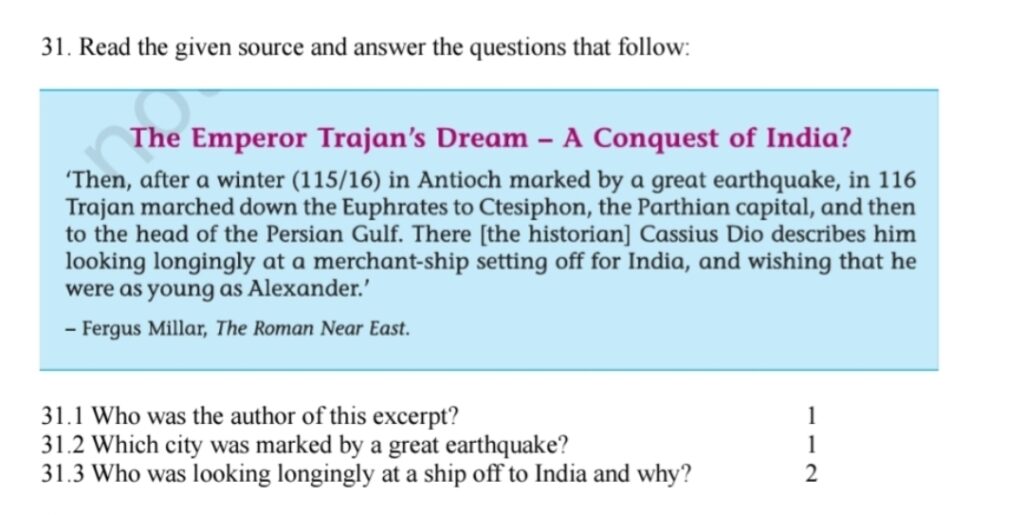
31.2 City: Antioch
31.3 Emperor Trajan looked at the ship, wishing to be young like Alexander to conquer India.
Q32.
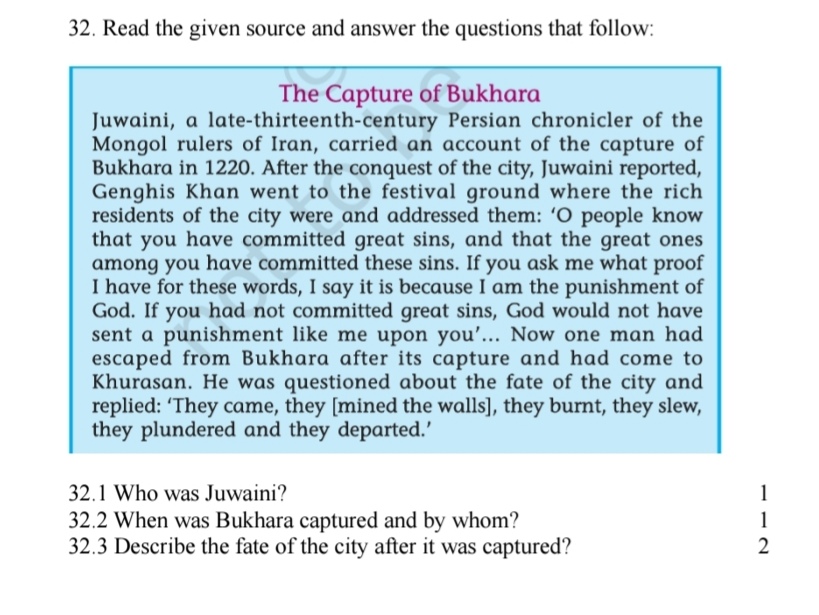
32.1 Juwaini – a Persian chronicler of Mongol rulers.
32.2 Bukhara was captured in 1220 by Genghis Khan.
32.3 Fate – walls mined, city burnt, people slain, plundered, and destroyed.
Q33.
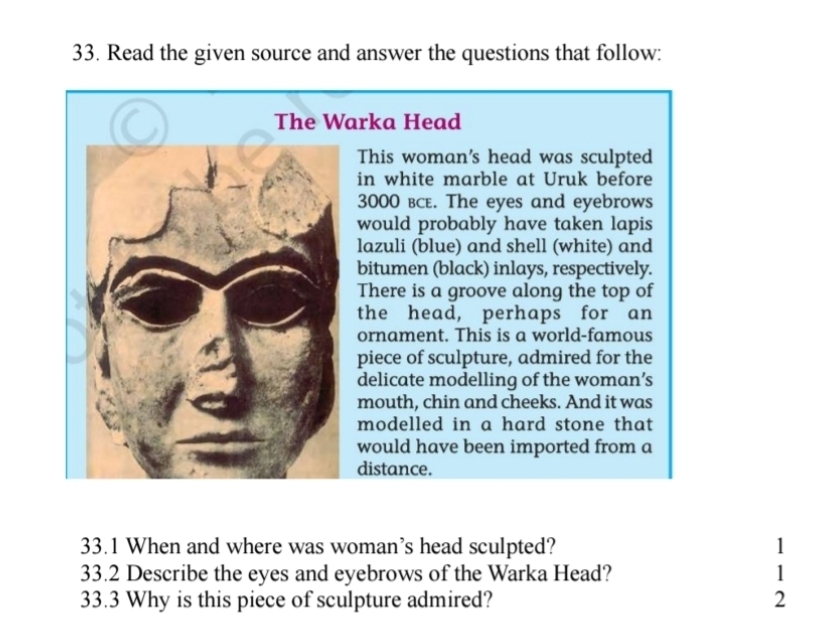
33.1 Sculpted before 3000 BCE at Uruk.
33.2 Eyes/eyebrows – inlaid with lapis lazuli, shell, and bitumen.
33.3 Admired for delicate modelling in hard imported stone.
SECTION E
? (Map Based) (5 Marks)
Q34.
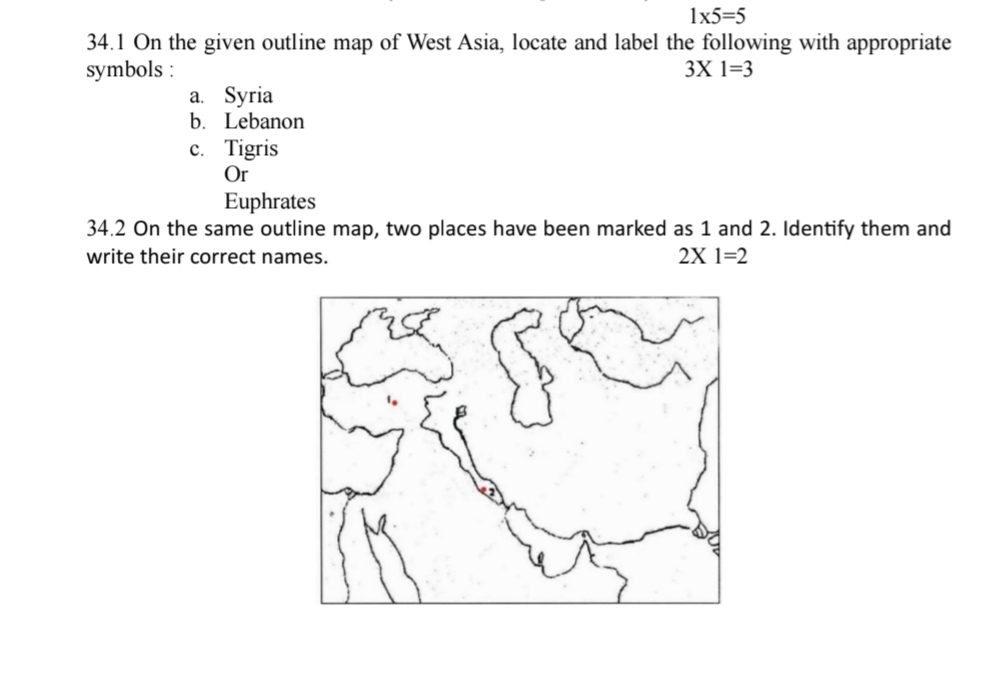
34.1 Locate and label:
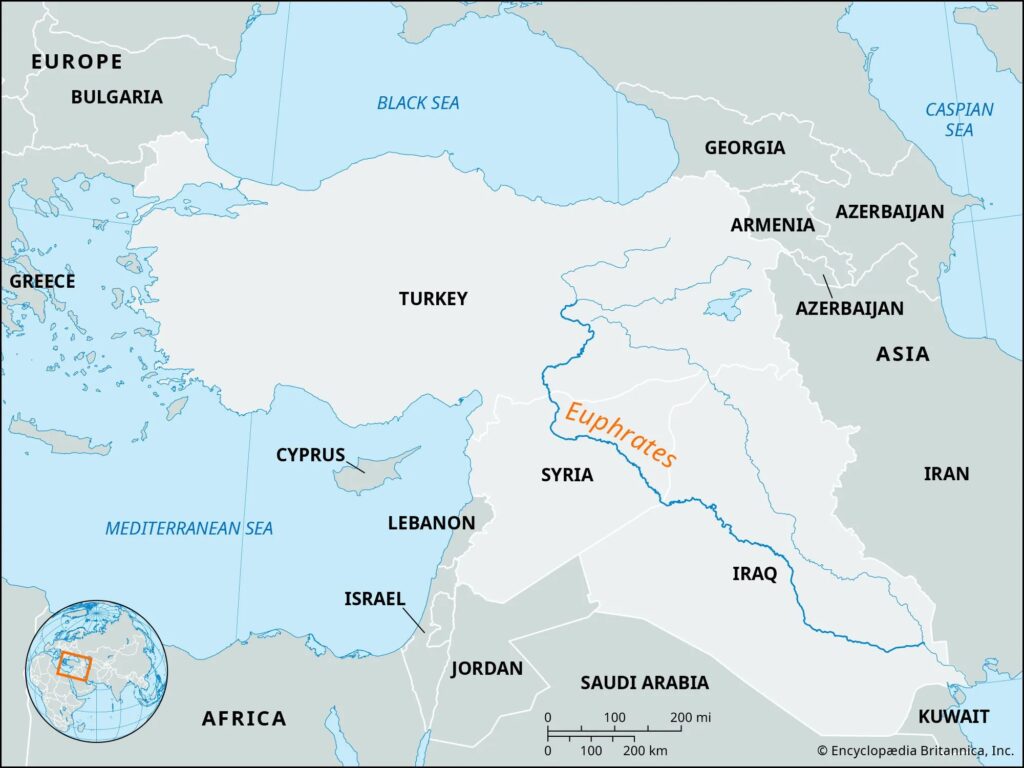
34.2 Identify places marked 1 & 2 → (Teacher usually provides map; correct names would be written after identification.)
For Visually Impaired Candidates:
34.1 Any three towns attacked by Mongols: Answer: Samarkand, Nishapur, Bukhara
34.2 Any two cities of Mesopotamia:
Answer: Ur, Uruk
